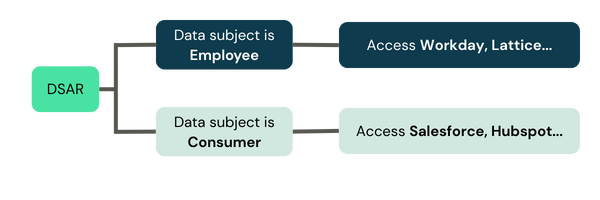Handling Employee vs. Consumer DSRs
Did you know DataGrail lets you automate DSR workflows to replace complex human processes? In this guide, you’ll learn how to set up a simple automation to manage employee DSRs, but automations can be leveraged for nearly any scenario.
Evaluate Your Request Process
By default, DataGrail will process requests Privacy Requests through all available integrations. Is that right for you? Take a look at your request process and consider:
- Do certain types of data subjects never have data in specific systems?
- Are certain users subject to required data retention policies?
- Do requests you deny have anything in common?
At a minimum, employee and consumer data are usually stored in separate systems (1), and employee data may be subject to certain retention policies, requiring manual intervention (2). Some orgs may choose not to process employee DSRs when not legally required (3).
Visualize Your Workflow
Sketch out the logic for how a request should be processed. In our example, we identify different systems as relevant depending on our relationship with the data subject.

We might also branch paths by the policy the request comes in under, the type of right exercised, or whether data is found in a certain system. Or, perhaps some integrations need to be processed before others.
Build Your Automation
Open the Automations tab from your sidebar in DataGrail Admin and choose Create Workflow. Pick a workflow type based on the phase of the request you hope to automate.
Requests start in Extracting Personal Data, and once all data is retrieved, move to Pending Action, giving the privacy manager an opportunity to review and modify results. Finally, deletion and pause processing requests move to Pending Delete. Each workflow type can automate actions in that phase and each subsequent phase.
You’ll assemble your workflow using a combination of Conditions (like whether or not the request is from an employee) and Actions. Your workflow can automatically:
- Deny requests when certain conditions are met
- Process integrations in a certain order
- Assign tickets to specific users
You can use Automations to intelligently automate requests end-to-end, or to simply to cut out a few steps for an individual assigned to manually process the request. Or, you might have a hybrid workflow where simple requests can be completed automatically, and the rest routed to your team.
Once you have your idea in mind, an automation only takes a few minutes to configure. Once your workflow is live, you can save hours of time on every request you receive moving forward.
Disclaimer: The information contained in this message does not constitute as legal advice. We would advise seeking professional counsel before acting on or interpreting any material.